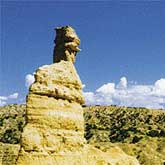Sedimentary Rock
 Sedimentary rock is one of three rock types on earth. Rock types are classified according to how the rock is formed. Igneous rock forms as it cools to a solid from molten rock. Metamorphic rock forms when rock is altered by intense heat, pressure, or both. Sedimentary rock is formed from particles derived from other rock through the processes of weathering, erosion, and deposition.
Sedimentary rock is one of three rock types on earth. Rock types are classified according to how the rock is formed. Igneous rock forms as it cools to a solid from molten rock. Metamorphic rock forms when rock is altered by intense heat, pressure, or both. Sedimentary rock is formed from particles derived from other rock through the processes of weathering, erosion, and deposition.
Sediments are eroded by flowing water in streams, by waves or ocean currents, by wind, ice, or gravity. Most erosion is done by flowing water. As eroded sediments move along, they grind against other rocks. This adds to the erosive power of the water, wind, or ice and further erodes the moving sediment. The grains become rounder, smoother, and smaller. The size and shape of the grains in a sedimentary rock give clues to its history. Coarse, angular grains could not have moved far from their source rock. Small, rounded grains must have been rolled along for hundreds of miles. Streams deposit tons of sediment into the oceans every day. In the oceans, sediment may be moved by currents and waves and later be dropped in layers upon the seafloor. Remains of organisms can be preserved as fossils as they drop and are quickly buried in accumulating sediments. Sedimentary rock is the only rock type containing fossils.
As layers of sediment build up, overburden pressure begins to squeeze the grains together. Water between the grains can leave once dissolved minerals behind after it is squeezed out or driven off by heat. These minerals cement the grains together into rock. Heat and pressure at burial depth can also fuse grains together into solid rock. As earth's forces cause the solid crust to move, sedimentary rock formed from sediments on the ocean floor or in valleys can be uplifted to the surface, perhaps reaching mountaintops. Some may become metamorphosed. Once at the surface, the rock is again exposed to weathering and erosion. New sediment forms, and the rock cycle continues. Because all rock at the surface is eroded and eventually forms new deposits, sedimentary rock is the most abundant rock type on earth.
About the Author
Claire-Jean Korzenewski, BS
 Claire-Jean Korzenewski has a B.S. in geology and experience in petroleum exploration. She is an educator with public school teaching experience in junior high and high school sciences. Claire-Jean is now a freelance writer who makes communications more effective - to inform, to educate, and to enhance profits for businesses and individuals.
Claire-Jean Korzenewski has a B.S. in geology and experience in petroleum exploration. She is an educator with public school teaching experience in junior high and high school sciences. Claire-Jean is now a freelance writer who makes communications more effective - to inform, to educate, and to enhance profits for businesses and individuals.


